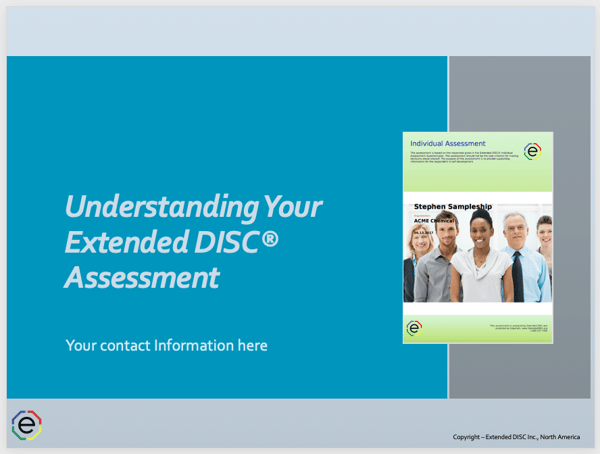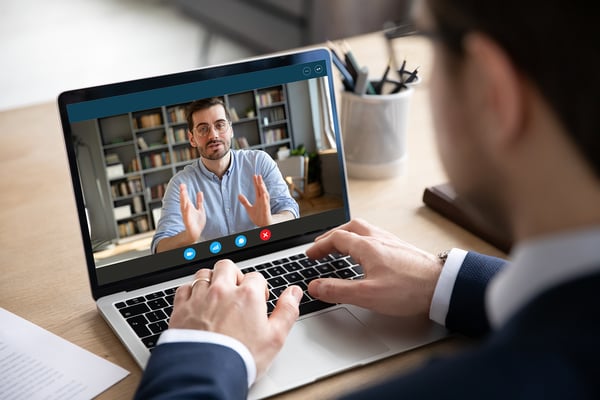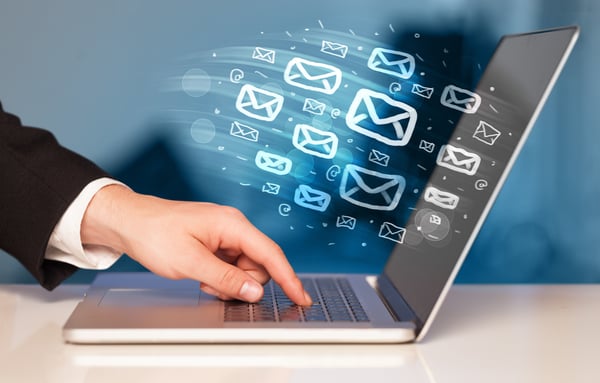Current times challenge us to be more innovative and adaptive in how we debrief DISC assessments.
I'm sure we can agree, the dynamics of a virtual debrief are different from an in-person one. Virtual meetings, while they cannot fully replace personal interactions, are a viable option for debriefing DISC assessments, especially if done well. The goal of any DISC debrief should be to help our clients understand and interpret their own results in order to improve their interactions.
Debriefing considerations
Many of us already debrief using phone calls and emails when in-person meetings aren't an option. We should continue to use those options and add virtual debriefs to give us even more flexibility. However, we need to keep in mind virtual sessions are not always a replacement for face-to-face ones; for some styles direct human contact is important.
On the positive side, you'll continue to do many of the things you've always done. For example, you'll work on building rapport and trust, review report results, discuss actionable next steps, etc. In addition, you can document the session to capture thoughts and moments.
An effective debrief is one you've prepared for and customized, so you're comfortable delivering it. In addition, you've built in flexibility and taken into account your client's learning style.
Tips for preparing the debrief

Here are some tips for a more effective virtual DISC report debrief:
- Build in extra time and flexibility.
- Debriefs, in general, tend to be broader in scope and therefore, cannot be as predictable.
- It may take more time to build rapport, explain things, discuss personal topics, manage technology, and provide instructions.
- Review your client's DISC profile to enhance the coaching session.
- Keep in mind how your own style may be similar or different from your client's style.
- How will you present the DISC assessment results?
- Does your client need a copy of their report?
- Present and discuss client's results by building in their DISC Assessment results into a PowerPoint presentation*.
- Become familiar with your technology so it doesn't become a distraction from the purpose of helping your client become more successful.
- Consider the best ways to shift your current coaching session to virtual ones.
- Establish a set of mutual agreements for how the session is run.
- Acknowledge distractions are more readily apparent (e.g., current world events, kids, dogs, etc.)
- Remind your client they are in control of the interaction and the shape of the debrief.
- It's personal; your client may have strong emotional reactions and discussions may need to happen.
- Think about the interaction.
- In a virtual debrief, your client may not be used to staring face-to-face on screen; it may not feel comfortable for some clients.
- You tend to lose the flow of energy. Energy, when not in person, is not as easily conveyed; you may need to bring more energy and variety to the session.
- You may have differing non-verbal cues and physical awareness (e.g., physical contact like shaking hands, showing you are fully present by leaning in, hard to avoid eye contact comfortably).
- Consider how to create a set of actionable steps so your client can practice and implement behaviors to be more successful.
- Use the 'Personal Action Plan: Next Steps' in the report
- Use supportive Extended DISC Reports including Reinforcement Workbooks and My Self-Study Workbook.
- Be open to other options; your client may prefer emails or phone calls or not be able to access technology.
Lastly, make it yours; the more comfortable you are the more effective the session will be.
Preparing your clients
You can further ensure a more smoothly run debrief by preparing your client. Remember, many of your clients are also adapting to how they connect to others. Also, consider the style of your clients; your more reserved styles may feel more comfortable if they have information up front.
- Materials
- Will they receive their results in real time or do you send a copy of the report prior to the debrief?
- Are there additional materials that would support them in the debrief (e.g., Extended DISC® Quick Reference Card)?
- Technology
- Can they test out the meeting link prior to session?
- Expectations
- Do they need to prepare anything other than taking the Extended DISC® Questionnaire?
- Is there an agenda or preview for the session?
Understanding your client's style can help you to better adapt your debrief to create a more meaningful and effective learning session. Let's review the different learning styles.
Debriefing your D-style

Your D-style learners tend to:
- be independent and action-oriented
- be more comfortable when the pace is brisk
- be multi-taskers so may not be giving you their full attention
- want a clear goal of what needs to be accomplished in the debrief
- focus on the big picture and less so on details and emotions
- want to be challenged
- express their opinions as facts
- be more motivated and excited when they feel the information advances them
- talk more and listen less; it's a way for them to maintain control of the interaction
They want you to tell them what are the benefits of their DISC results; essentially focusing on the bottom line. What can they do with the results? How can they use it improve their performance?
In your debrief, you may want to highlight key parts of their report and let them take the lead. Let them describe themselves and pull what they consider to be relevant from their report. They will be more focused and interested in essential information that is relevant to them.
Debriefing your I-style

Your I-style learners tend to:
- not analyze what is being said
- react emotionally to what they hear
- respond when you focus on the positive aspects of their results
- disengage when focusing on the negative aspects
- be more engaged when you keep up the pace and energy
- need time for small talk and opportunities to talk about themselves
- want variety; change it up by incorporating stories, and activities
Your I-style clients are eager learners who prefer to talk over listen. They are more likely to listen to short and exciting stories and will show more interest when they can participate and share their ideas. I-styles tend to be enthusiastically involved, but may lose concentration and become sidetracked.
In your debrief with your more emotional I-style learners, focus less on details, build in more time to chat, and give opportunities for them to talk. They will be more receptive to information if you can present it more positively and provide opportunities to create and enjoy their successes.
Debriefing your S-style

- be active listeners to your detailed information
- not offer a lot of feedback because they are focusing on the message
- learn better in a controlled environment and by understanding logical processes
- be more resistant if the message is about change
- come across as modest and more focused on the negative
- listen carefully without interrupting
Your session with your amiable S-style clients may be more subdued. They tend to be attentive, but may not speak unless you ask them questions.
In debriefing your S-style clients, you may want to slow the pace down and allow time to ask questions. Try explaining things carefully, stick with proven ideas, and stop to check for understanding.
Debriefing your C-style:
 Your C-style learners prefer:
Your C-style learners prefer:
- logical, fact-based learning where they can focus on details
- you to proceed logically and calmly
- proven ideas; avoid untested and more abstract solutions
- learning by criticizing
- ask more questions if they want to learn more about what you're talking about
- not to provide immediate feedback
Your more reserved C-styles may be quieter, in order to process the information and listen. If they are interested, they may ask a lot of questions to better understand the data. Remember, don't get too personal, slow down, and answer questions carefully.
Also, your C-style client may prefer email exchanges whenever possible. For example, introductory emails can give your C-style clients an opportunity to learn more and be prepared, while follow-up emails allow for additional questions and information to reviewed at their own pace.
Special note about privacy
A virtual debrief is different from an in-person one because you're coaching remotely, covering personal topics in settings that may or may not be comfortable for your client to address or discuss. Coaching, unlike a training or meeting, can also to be broader in scope; sometimes difficult to predict or follow an agenda.
- It's important to consider and create a comfortable and private space for you and your client.
- Be mindful, your client may be sitting at their open area desk where others can overhear the conversation.
- In current times, they are likely to be at home where there are more distractions. Home can also be a place your client feels more comfortable and may end up feeling more open to receiving results and sharing of thoughts.
- If you are sharing the results electronically, such as in a PowerPoint, know how to protect your client's privacy (e.g., GDPR for European Union citizens).
Special times calls for added attention
- Practice your own DISC awareness by using it to better adapt the DISC debrief to engage and motivate your client's style.
- Pay special attention to your clients right now; their ability to take in information and stress load may be temporarily altered.
- Check your client's DISC profile to see how they show up under pressure.
- Do they need a personal check-in, or would more frequent, shorter, simple sessions, be more comfortable?
- Option - assign brief and practical homework tasks to reinforce their ability to interact well with others; both personal and professional.
Technology is relatively easy to learn and use when debriefing virtually, and most importantly, provides you with opportunities to continue working with your clients.
*We have an Extended DISC® 'Understanding Your Extended DISC Assessment,' PowerPoint Presentation for our Extended DISC clients to customize. Contact us Info@ExtendedDISC.org to learn more!
